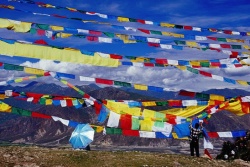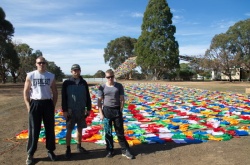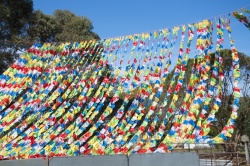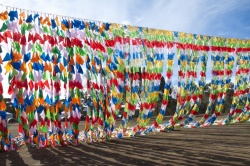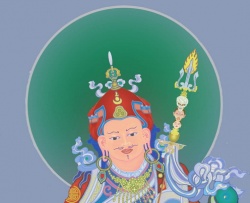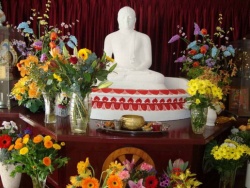Prayer Flags
In the West as in other places, the property of a Tibetan Buddhist is often bounded by a string of thin cotton flags in 5 primary colors: blue, white, red, green, and yellow. The colours stand for the traditional elements: space (sky), air (clouds) and fire, water, and earth respectively that are also associated with the 5 Buddha families.
They are printed with pictures, designs and writing by means of inked wood blocks.
The small horizontally-flown type of Tibetan flag is properly called dar-ding. Colloquially, the small flag is called "windhorse" or lung-ta though it may not always display the image and prayer associated with that figure.
The vertical kind, flown from a pole as a kind of offering, is called dar-cho. A dar-chen is the large banner flown from a pole that is found outside temple gates or on the roof.
Flags inscribed with mantras, prayers and protective inscriptions are raised to mark auspicious occasions. They are considered to be activated by the wind, and so they function somewhat in the nature of prayer wheels.
In the Tibetan calendar, some days are more auspicious than others for the beginning of new enterprises, including the hanging of prayer flags.
The origin of the use of flags in Tibet was militaristic, as it is in most other cultures. This is indicated by the Tibetan term for banner which is Ru-dar. Ru refers to the mustering of a clan for combat or the gathering of nomads before the migration to fresh pastures. The word ru-dar when found in ancient literature refers to military flags.
The collection of Bonpo teachings, Yung-drung Tsangma Zhang-zhung, states that if you attach a mantra wrapped in silks of the 5 colours to the top of a victory banner and pray to it worshiping it with precious offerings, then you will accomplish all goals.
The practice developed into flag flying, and designs began to serve the function of religion. One common emblem has a tiger, a snow lion, a garuda, and a dragon in its four corners, and in the center is a horse around which is the Bon mantra, "May the horse of good fortune run fast and increase the power of life, influence, fortune, wealth, health, and so forth."
April 13-14, 2009: You can learn the ancient tradition of creating prayer flags at the Ligmincha Institute’s Serenity Ridge retreat center near Charlottesville, Virginia in the USA.
The Buddhist Basis
The protection afforded by mantras is illustrated by the following Buddhist story:
When Buddha was in the Thirty-third Realm of the Gods, seated on a flat stone as white as his clothes, Indra, king of the Gods came and prostrated before him. Indra explained that he and the gods of the Thirty-third realm had suffered a great defeat at the hands of Vemchitra, the king of the anti-gods, and he asked Buddha what he should do. Buddha told him to memorize the mantra contained in the prayer Ornament at the Crest of the Victory Banner. Buddha explained that he had received this mantra from the Tathagata known as Irrepressible and had himself taught it to many disciples. He said that since the time that he learned the mantra he could not remember even a moment when he felt fear or terror, so he told Indra to carry this mantra into battle to ensure victory.
Great masters have written ritual texts praising the Dra-lha, a deity who helps in overcoming obstacles and enemies, and the hoisting of Dra-lha flags is meant to cause the Dharma to flourish and to promote the welfare of all sentient beings, especially those who engage in these rituals.
In an old Dra-lha story, the gods were enjoying the fruits of the wish-fulfilling tree, which grew in the valley of Mt. Meru. As the tree was rooted in the realm of the anti-gods, they claimed that the fruit was also theirs, and a battle ensued. Indra went to Vajrapani and asked him for assistance. Vajrapani told Indra to invite the brothers of Dra-lha and
to ask for their help. Nine weapons and nine deities then appeared from the great ocean. Through the worship of these deities Indra was able to defeat the anti-gods and achieve victory.
It has been recognized internationally since before 1934, when it appeared in that September's National Geographic (vol. LXVI, no. 3, p. 383) in the leading article, "Flags of the World" by Gilbert Grosvenor and William J. Showalter. The text reads, "Tibet. -- With its towering mountain of snow, before which stand two lions fighting for a flaming gem, the flag of Tibet is one of the most distinctive of the East."
According to Jamyang Norbu, it is likely that the National Geographic Society had obtained the Tibetan flag from Society member, Tsarong Dasang Dadul, commander- in-chief of the Tibetan army. Namchen, The Dream Flag
HH the 16th Gyalwa Karmapa (d. 1981 in Chicago) conceived of this blue and yellow flag in a dream. Besides representing the Ocean of Wisdom [Tib. gyalwa or Mong. dala) or the interplay of Wisdom and Method, or of Compassion and Means, it is also an apt symbol for Mahamudrae reciprocal attitude that is the view of the Kagyu denomination.
The Peaceful and Soothing Banner of Victory
"The two rising curves of pure gold are great joy's loving, radiant smile;
The vibrant blue reflects the ultimate, dharmakaya . . . "
~ from stanza two of the poem Melodious Song of the Battle: Victorious Over Maras by the 17th Karmapa, advised by Thrangu Rinpoche, and translated by Michele Martin.
About Brocade, the maker of this flag.
More about prayer flags, from Me-long: Newsletter of the Council for Religious and Cultural Affairs of H.H. the Dalai Lama, No. 7, December 1990.
Traditional Wind Horse Prayer Flag
Here is what is on the usual Windhorse prayer flag:
Other Traditional Tibetan Hangings
Aside from shambu, which are pleated window and door decorations that can be found in a traditional Tibetan home, many other traditional adornments formerly found in prayer halls have found their way into Western homes. These include:
Namteng: a ceiling hanging forming a short, square canopy over a lama's throne;
chep'hur, which are cylindrical rainbow banners made of brocade points;
kap'hen, a flat rainbow brocade hanging generally used to cover the sides of pillars;
gyaltsen, a flat banner sometimes embroidered with Om Mani Peme Hung, or the 8 auspicious symbols.
_________________________________________________________________________
Genghis' flag: It was likely a 3:2 white standard with 9 black horsetails attached to the fly. E. Har-Davan. Chinghis the Commander and His Successors. </poem>

